Bangladesh
Template:Infobox State/Maintenance/TRANSCRIPTION
Template:Infobox State/Maintenance/NAME-German
Bangladesh (Bengali বাংলাদেশ Bāṃlādeś [ˈbaŋlaˌd̪eʃ]; composition of bangla 'Bengali' and desch 'country') is a state in South Asia. It borders the Bay of Bengal to the south, Myanmar to the southeast, and is otherwise enclosed by the Indian states of Meghalaya, Tripura, West Bengal, Mizoram, and Assam. With a population of about 165 million (2017) in an area of 147,570 sq km, it ranks eighth among the world's largest states by population and seventh among states by population density. By area, however, it is among the medium-sized states, ranking 92nd. The capital Dhaka is one of the fastest growing megacities in the world; other megacities are Chittagong and Khulna.
Bangladesh occupies the eastern part of the historical region of Bengal, which became the eastern part of Pakistan in 1947 under the name East Pakistan due to the Muslim majority in the partition of British India. In 1971, as a result of the Bangladesh War, East Pakistan gained its independence under the name Bangladesh. The designation of a national of the country is Bangladeshi.
The country is characterized by the monsoon, the delta of the Brahmaputra, Ganges and Meghna rivers with their extensive swamps and sundarbans, its location by the sea and the predominantly flat lowlands. The combination of these features make for frequent flooding and momentous inundation of the densely populated country. Globally rising sea levels are expected to exacerbate the problems.
Thanks to an economic upswing, Bangladesh has been able to greatly improve its social and economic indicators, although it remains one of the poorest countries on the Asian continent. Thanks to its growing economy and young population, it is now one of the emerging Next-Eleven markets. The United Nations Development Programme classifies Bangladesh as a country with medium human development.
Geography
Bangladesh borders the Indian states of West Bengal, Assam, Meghalaya, Tripura and Mizoram (clockwise, starting in the west), as well as Myanmar and the Bay of Bengal (part of the Indian Ocean). The total length of the border is 4246 km, including 193 km with Myanmar and 4053 km with India. The length of the coast is 580 km.
Nature area
Most of Bangladesh is formed by the estuarine delta of the Brahmaputra, Ganges and Meghna rivers; a swampy area crisscrossed by many oxbow lakes, pools and small islands, which is regularly flooded by river floodwaters during the monsoon season. About 90 percent of Bangladesh consists of flat lowlands, and the capital Dhaka is only six meters above sea level. Only the southeastern part of the country with the hilly and mountainous landscape of the Chittagong Hill Tracts deviates from this appearance.
Vegetation
Since the natural tree population was decimated over a large area in the course of intensive agriculture, only 15 percent of the country is forested. Tropical rainforests exist mainly in the southeastern hill country, while extensive mangrove vegetation predominates in the catchment area of the river deltas. These areas called Sundarbans (after the up to 25 m high Sundari trees) are with an area of about 10,000 km² the largest mangrove forests on earth. They account for about half of the country's remaining forest area.
Climate
The climate of Bangladesh is tropical with increasing rainfall from west to east. Bangladesh lies in the sphere of influence of the southwest monsoon, resulting in an average annual rainfall of 1500 to 2250 mm. In the east, at the foot of the Tripura-Lushai mountains, 3000 to 4000 mm fall. There is the highest elevation of Bangladesh, the Mowdok Mual (1045 m). More than half of the annual precipitation falls in the months of June to August. In March/April and October, tropical cyclones often occur over the Bay of Bengal with often catastrophic consequences, as the associated floods inundate large parts of the country. One-fifth of the country is flooded annually, rising to 35% in extreme floods. The average daily maximum temperature is 25 °C in January and as high as 35 °C in April. During the rest of the year the temperature is around 30 °C. In Bangladesh, there are three distinct seasons: from the end of May to the beginning of October, the monsoon season; from mid-October to the end of February, the "cool" season; and the "hot" season, roughly between March 15 and May 15.
Effects of climate change
Bangladesh is particularly affected by global warming: Due to its geographic conditions - most of the country is only slightly higher than sea level - its large population of about 160 million people, and the fact that the population settles on very little land and about 80% of it lives below the poverty line, it faces particular challenges in adapting to the consequences of global warming. If sea levels rise by one meter, without coastal protection measures, about 18% of Bangladesh's total land area would be flooded, causing about 38 million people to lose their homes and become climate refugees. The IPCC's Fifth Assessment Report of 2013 projected a rise of between 0.26 m and 0.98 m by 2100, depending on the underlying scenario, and projected further rise for the following centuries due to long-term effects of greenhouse gas emissions. In the long term, sea level rise is projected to be about 2.3 m per additional degree Celsius of warming. The actual sea level rise in the region is 1.06 - 1.75 mm p.a. From 1977 to 2010, Bangladesh has experienced a net increase of 169 km² due to changes in the coastline.
Due to the rising sea level, an increasing salinization of groundwater and arable land can be observed. In addition, about 65% of the population lives in the river delta, which is frequently affected by flooding. The increased melting of the Himalayan glaciers and a change in precipitation in the catchment area of the rivers as a result of global warming will increase the risk of flooding in the future. In the northwest, on the other hand, there would be a decrease in precipitation and more severe drought, which in turn would affect the water supply there. Both soil salinization and changes in the monsoon are expected to reduce crop yields by up to 30% by 2050. Moreover, as social tensions are already present in the affected area and climate change-induced migration towards Dhaka and other urban centres is leading to congestion of urban infrastructures, it is feared that these will develop into open violent conflicts due to deteriorating living conditions as a result of climate change. Similarly, conflicts over fertile lands in rural Bangladesh are associated with climate change. In this regard, indigenous ethnic groups such as the Santal or the residents of the ChittagongHill Tracts are often the victims of attacks. In 2019, Bangladesh's gross domestic product was projected to shrink by 4.3% by 2030 due to climate change. The consequences will particularly affect already disadvantaged population groups.
Natural disasters
Due to its location near the equator at the sea in a tectonically unstable zone (in relative proximity to the Himalayas), Bangladesh is hit by natural disasters at irregular intervals. These include cyclones - tropical cyclones and the partly associated storm surges, as well as landslides and earthquakes.
| Major cyclones in Bangladesh in recent times | |||
| Date | Max. Wind speed (km/hour) | Height of storm surge | Casualties |
| 11 May 1965 | 161 | 3,7–07,6 | 19.279 |
| 15 Dec 1965 | 217 | 2,4–03,6 | 873 |
| 1 Oct 1966 | 139 | 6,0–06,7 | 850 |
| 12 Nov 1970 (Bhola) | 224 | 6,0–10,0 | approx. 300,000 |
| 25 May 1985 (1B) | 154 | 3,0–04,6 | 11.069 |
| 29 Apr 1991 (02B) | 225 | 6,0–07,6 | 138.882 |
| 19 May 1997 (01B) | 232 | 3,1–04,6 | 155 |
| Nov 15, 2007 (Sidr) | 223 | 3.363 | |
| May 25, 2009 (Aila) | 092 | 190 | |
Wildlife
In the rainforests near Chittagong one can find deer, bears, leopards, rhesus monkeys and elephants. In total, about 750 species of birds, 250 species of mammals and 150 different reptiles and amphibians are known in Bangladesh. The reptiles of the country include crocodiles, pythons and cobras. In addition, in the waters of Bangladesh live about 250 species of freshwater and on the coast about 350 species of marine fish; fishermen hunting for lobsters and shrimp often bring home a large catch, which on the one hand serves as food for the local population, on the other hand is also used for export. Probably the most famous animal of Bangladesh is the Bengal tiger, also called Indian or Royal Bengal tiger. This tiger species lives in the southeast of Bengal. Male specimens can reach a length of 3 meters, weigh a quarter of a ton and reach a shoulder height of one meter. Red-golden fur with black stripes is the characteristic of this tiger, whose belly area is colored white. Occasionally, white Bengal tigers are also sighted. Bengal tigers eat about nine kilos of meat per day. In Bangladesh, an estimated 670 tigers live in the protected mangrove forest area of the Sundarbans.
Management structure
Divisions
→ Main articles: Division (Bangladesh), District (Bangladesh) and Upazila
Bangladesh is divided into eight administrative divisions, which in turn are subdivided into 64 districts. The districts are further subdivided into circles (upazilas). All divisions are named after their capital.
The Divisions are:
| Divisions of Bangladesh 2017 | ||||
| Division | Capital | Area in km² | Population 2016 | Population density |
| Barishal | Barishal | 13.297 | 9.145.000 | 688 |
| Chittagong | Chittagong | 33.771 | 31.980.000 | 947 |
| Dhaka | Dhaka | 20.551 | 40.171.000 | 1.955 |
| Khulna | Khulna | 22.272 | 17.252.000 | 775 |
| Maimansingh | Maimansingh | 10.569 | 12.368.000 | 1.170 |
| Rajshahi | Rajshahi | 18.197 | 20.412.000 | 1.122 |
| Rangpur | Rangpur | 16.317 | 17.602.000 | 1.079 |
| Sylhet | Sylhet | 12.596 | 11.291.000 | 896 |
In 2015, the Bangladeshi government announced that two more new divisions would be formed, Faridpur from parts of Dhaka and Kumilla from parts of Chittagong.
Cities
The capital Dhaka, the country's largest city ahead of Chittagong and Khulna, had a population of 5,378,023 in the city proper (9,912,908 in the agglomeration) as of the January 22, 2001 census. In 2010, the number of inhabitants is estimated at about 15 million. Almost half of them live in slums. As one of the fastest growing cities in the world, Dhaka belongs to the megacities.
The largest cities are (2011 census):
- Dhaka: 8,906,039 inhabitants
- Chittagong: 2,592,439 inhabitants
- Khulna: 1,400,000 inhabitants (2014 census)
- Rajshahi: 448,087 inhabitants
- Sylhet: 369,425 inhabitants (2007 census)
See also: List of cities in Bangladesh
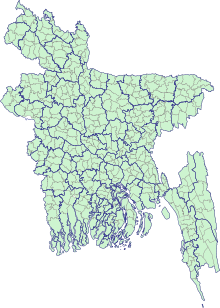
Administrative division into districts and sub-districts (upazilas) in 2013.
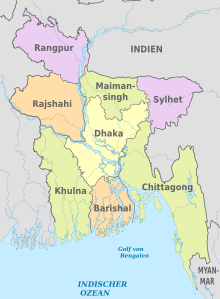
Administrative units of Bangladesh

The Royal or Bengal Tiger is one of the national animals of Bangladesh.

Route of the 1970 Bhola cyclone, the most devastating cyclone in Bangladesh in the 20th century.
Population
Demographics
| Fertility rate | |
| Time period | Fertility rate |
| 1950–55 | 6,36 |
| 1955–60 | 6,62 |
| 1960–65 | 6,80 |
| 1965–70 | 6,92 |
| 1970–75 | 6,91 |
| 1975–80 | 6,63 |
| 1980–85 | 5,98 |
| 1985–90 | 4,98 |
| 1990–95 | 4,06 |
| 1995–2000 | 3,43 |
| 2000–05 | 2,93 |
| 2005–10 | 2,48 |
| 2010–15 | 2,23 |
| 2015–20 | 2,05 |
With just under 165 million inhabitants (as of 2020), Bangladesh ranks eighth in the list of country populations and is the most denselypopulated territorial state in the world, with a population density of 1084.2 people per square kilometre. For a long time, Bangladesh had a high birth rate. Self-help initiatives by the population, supported by development aid organizations, reduced the total fertility rate from 7.0 to 3.3 children per woman between 1979 and 1999. The combined fertility rate was only about 2.05 children in the 5-year period between 2015 and 2020, according to United Nations estimates. The population is projected by the United Nations in 2017 to grow to over 200 million by 2050 and then begin to stagnate.
Surveys in 1999 showed that the people in Bangladesh, with 3.3 children per woman at that time, had far more children than they actually wanted (on average only 2.3 children). Due to the widespread poverty in Bangladesh, some of the women did not have access to safe and effective methods of family planning.
In 2017, 0.9% of the population was foreign-born. During the riots against Rohingya in neighbouring Myanmar, about 850,000 Rohingya fled to Bangladesh by the end of 2017. Bangladesh itself is a country of emigration. In 2016, 7.5 million native Bangladeshis lived abroad, mainly in India, the Arab Gulf states, the USA and Europe.
In 2011, 28.4 percent of the population lived in urban areas. According to World Bank figures, poverty in Bangladesh fell from 48.9% to 24.3% of the population from 2000 to 2018, and extreme poverty fell from 33.7% to 12.9%.
In almost all parts of the country the population density is above 500 inhabitants/km². Only in the districts around Chittagong (except Cox's Bazar) it is between 75 inhabitants/km² and 500 inhabitants/km². The areas with the highest population density are Narsingdi and Narayanganj with more than 2000 inhabitants/km² and the capital Dhaka with more than 7000 inhabitants/km².
Languages
In contrast to the other states of South Asia, Bangladesh is ethnically relatively uniform: Bengali, which is one of the Indo-Aryan languages, is spoken by about 98 % of the population as a mother tongue. The Bengali language played a central role in the struggle for independence and, as the country's official language, is still of great importance for national identity today.
English is widely spoken among the middle and upper classes as a language of education and is used as a language of administration and business - but unlike neighbouring India, English has no official status as an official language. A total of 39 different languages and idioms are spoken.
Among the few minorities are the Bihari (1%), who came from Bihar to what was then East Pakistan because of religious conflicts following the partition of British India at independence. They speak mostly Urdu. In addition, there are two minorities in the Chittagong Hill Tracts in the southeast and north of the country who are matrilineally organized: the Khasi (the Khasi is a Mon-Khmer language) and the Garo (the Garo is a Tibetan-Burmese language). Both ethnic groups were separated from their tribal communities in the neighboring Indian state of Meghalaya by the 1972 border demarcation.
Religion
Denominations
The majority of the population, about 90 percent, professes Islam. Of this, a large part is of the Sunni faith, Shiites are present in a minority. Islam is the state religion in Bangladesh. A case that had been pending for 28 years to remove this passage from the constitution was rejected by the country's High Court in 2016. Hinduism is represented by just under nine percent and Buddhism by less than one percent. In the longer historical survey, the relative share of Muslims has steadily increased, while the share of Hindus has decreased. According to the official population statistics in 1941, i.e. the last census year before the partition of India, 70.3% Muslims and 28.0% Hindus lived in the territory of what later became Bangladesh. After Bangladesh's independence, the figures were 85.4 per cent Muslims and 13.5 per cent Hindus in 1974, while in 2011 these figures were 90.4 and 8.5 per cent respectively. Khulna, Rangpur and Sylhet divisions had the highest proportion of Hindus in all statistical surveys since 1974 (between 12.8 and 14.1 per cent in 2011). Buddhists live predominantly in the Chittagong Hill Tracts and constituted about 3 percent of the population in the Chittagong Division in 2011.
| Religions in Bangladesh 1974-2011 | ||||||||||||
| Census | Population total | Religions |
| |||||||||
| Muslims | Hindus | Buddhists | Christians | Other |
| |||||||
| Number | % | Number | % | Number | % | Number | % | Number | % |
| ||
| 1974 | 071.478 | 061.039 | 85,4 | 09.673 | 13,5 | 439 | 0,6 | 216 | 0,3 | 111 | 0,2 |
|
| 1981 | 087.120 | 075.487 | 86,7 | 10.570 | 12,1 | 538 | 0,6 | 275 | 0,3 | 250 | 0,3 |
|
| 1991 | 106.315 | 093.881 | 88,3 | 11.179 | 10,5 | 623 | 0,6 | 346 | 0,3 | 286 | 0,3 |
|
| 2001 | 124.355 | 111.393 | 89,6 | 11.608 | 09,3 | 774 | 0,6 | 389 | 0,3 | 191 | 0,2 |
|
| 2011 | 144.044 | 130.205 | 90,4 | 12.300 | 08,5 | 890 | 0,6 | 447 | 0,3 | 202 | 0,2 |
|
Islam
Islam as state religion versus secularism
The first constitution of Bangladesh in 1972 enshrined secularism as one of its fundamental principles. After the assassination of President Mujibur Rahman in 1975, the military regime (1975-1977) under General Ziaur Rahman replaced the term "secularism" with the passage "Absolute trust and faith in Almighty Allah shall be the basis of all action" through the 5th Amendment to the Constitution issued by Presidential Decree. On June 9, 1988, the Bangladeshi Parliament, which was entirely under the influence of the military regime of General Ershad, passed the 8th Amendment to the Constitution declaring Islam as the state religion of Bangladesh. The amendment read, "The state religion is Islam, but other religions may also be practiced in peace and harmony in the republic." The religious minorities in the country and the opposition Awami League protested in vain against this departure from the principle of secularism. These regulations initially remained untouched after the end of the military governments in 1990.
On 29 August 2005, the Supreme Court of Bangladesh declared the military governments between 15 August 1975 and 9 April 1979 illegal. This also annulled the 5th Amendment introduced by them and restored the secular constitution in the 1972 form in these sections. Representatives of the two conservative ruling parties at the time, Bangladesh Nationalist Party (BNP) and Jamaat-e-Islami, objected to this and appealed. However, on February 3, 2010, the Appellate Division of the Supreme Court affirmed the previous decision, eliminating the 5th Amendment. The ruling was published on 28 July 2010.
The 8th Amendment (Islam as the state religion) remained unaffected by this ruling. Critics described it as a contradiction when on the one hand the state defines itself as secular, but on the other hand Islam is supposed to be the state religion, and also called for the repeal of the Eighth Amendment. In 2011, the Supreme Court even asked the government to explain why the Eighth Amendment should continue to exist when the Fifth Amendment had been repealed. As early as 1988, 15 prominent Bangladeshi personalities had filed a constitutional petition against it. The writ petition did not make any headway for a long time but was then reactivated again after the 2010 verdict. In a brief hearing before the Supreme Court on March 27, 2016, the court dismissed the suit and affirmed the continued validity of the 8th Amendment.
Role of Islam in legislation and society, other religions
Sufism is widespread among Muslims, and the Tablighi Jamaat also has a large following in Bangladesh. Since the 1980s, the influence of Islamic fundamentalists has also been growing.
At the beginning of the 20th century, 33.9 percent of the population were Hindus. Since then, this proportion has declined sharply. Before the partition of India in 1947, 28 percent of the population were still Hindus, but almost four million Hindus then fled to India. In the war of independence in 1971 the Pakistani army, together with the local Islamist militias supporting it, took particularly brutal action against the religious minorities, who were collectively accused of supporting the independence movement. Among the at least 500,000 dead (maximum estimates up to 3 million) of the war were also many Hindus.
Christianity accounts for about 0.3 percent of the population (mostly Roman Catholic). Animism is rather rare; its share is estimated at about 0.1 percent.
Although Islam plays a certain role in legislation, there is no formal implementation of Sharia law in Bangladesh. Islamic legal concepts are only applied to Muslims. Family law differs somewhat between religions. Male Muslims are allowed to take up to four wives with the written consent of the first wife. In reality, this rarely happens, and there is strong social pressure against polygamy. Hindus are only allowed to divorce under certain circumstances (unwanted childlessness, abuse, mental illness). Hindu widows are allowed to legally remarry. There are also no legal restrictions on marriages between members of different religions. However, the legal provisions can only be invoked if the marriage has been officially registered, which is not compulsory. The many child marriages are criticized. Over 60% of girls are married before they reach the legal minimum age of 18. A 2017 amendment to the law stipulates that girls may be married immediately after birth.
Members of religious minorities are also represented in the government of Bangladesh (in 2012, 5 out of 51 ministers were non-Muslims: 2 Buddhists, 2 Hindus, 1 Christian). Non-Muslims are also represented in the higher administration. However, there are no official statistics that allow a statement on the extent to which these minorities are represented in accordance with their share of the population.
The Vested Property Act of the 1960s, which was in force until 2001, allowed the government to expropriate land from "enemies of the country" (in practice, virtually all of them Hindus). Typically, these were Hindus who had fled to India and whose supposedly ownerless land was confiscated by the state. As a result, 2.6 million acres (10,500 km²) came into government possession over the years. The Hindus concerned tried to reclaim their land through the legal process. The Vested Properties Return (Amendment) Bill in 2011 required the government to publish lists of confiscated land, which can be used to make claims for restitution.
Islamism
Islamist political parties have at times in the past won up to 15% of the vote in parliamentary elections in Bangladesh. By far the largest Islamist party is Jamaat-e-Islami (JI), which supported the Pakistani side in the war of independence and was banned for several years afterwards. Since around 2009, leading JI politicians have been tried by a special court set up by the Bangladeshi government for their involvement in human rights crimes during the war of independence, and some have been sentenced to death and long prison terms. This has led to the radicalization of some of the followers. Since the late 1990s at the latest, militant Islamist groups such as Jamaat-ul-Mujahideen Bangladesh have been active, carrying out bomb attacks on state institutions. The global activities of al-Qaeda and the so-called "Islamic State" have also led to increased Islamist activity in Bangladesh. It is disputed to what extent these are copycat acts and how far these two organizations have spread in the country.
Since around 2013, Islamist assassinations of secularists have become an increasing problem that has attracted the attention of the world public. The murder victims were usually bloggers on social networks, journalists or book authors who had publicly professed and promoted atheism. The victims were typically attacked by a group of Islamic extremists and hacked to death in brutal fashion with machetes in full view of those around them. Among the best-known victims was Avijit Roy (d. February 26, 2015). Since around 2015, there have also been increased attacks on members of religious minorities (Hindus, Christians, Buddhists).
See also: Buddhism in Bangladesh and Roman Catholic Church in Bangladesh
Education
In Bangladesh, the median length of schooling for people over 25 years increased from 2.8 years in 1990 to 5.2 years in 2015. The country has achieved significant successes in primary education, with an enrolment rate of around 95 per cent, even if a large proportion then leave school without completing their education. Despite compulsory education, the state is not in a position to provide an adequate educational infrastructure. There are therefore a large number of private schools and schools run by non-governmental organisations. In addition to mostly Bengali-language state schools, there is an increasing number of English-language private schools. Bangladesh's public education system follows the British model, which was introduced in England in 1947. There is an official five-year compulsory education and attendance at public schools is free. However, many students leave school without graduating. As a result, the number of students in secondary education is falling, and the proportion of girls in the higher grades is much lower than that of boys. Therefore, for girls from grade 6 onwards, part of the monthly cost is covered by the government. In 2015, 38.5% of all Bangladeshis above 15 years of age were illiterate. Among women the rate was 41.5 %, among men 35.4 % could not read and write.
The state education system comprises four main levels: Five years of elementary school are followed by three years of middle school from sixth to eighth grade. After that comes the two-year high school education, which is completed with a Higher Secondary School, HSC examination. Successful completion of Higher Secondary School entitles the student to attend a government college or university. There are over 105 recognized government and private universities in Bangladesh. A Bachelor's degree takes four years and a Master's degree takes six years. After that, there is also an option to pursue a doctorate. Universities in Bangladesh are highly politicized. Student unrest and violent clashes between students occur regularly, often remotely controlled by the two major parties BNP and Awami League and the religiously oriented Jamaat-e-Islami.
In addition to the state schools, there are thousands of madaris or madrasas, which are largely financed by Saudi Arabia. As a rule, they also offer free basic education to children from poor families who would not be able to attend a state educational institution. Their teaching content is only partially under state control.
See also: List of universities in Bangladesh
Health
| Development of life expectancy over time | |||
| Period | Life expectancy in | Period | Life expectancy in |
| 1950–1955 | 40,7 | 1985–1990 | 57,0 |
| 1955–1960 | 44,2 | 1990–1995 | 60,0 |
| 1960–1965 | 47,2 | 1995–2000 | 63,7 |
| 1965–1970 | 49,3 | 2000–2005 | 66,7 |
| 1970–1975 | 46,3 | 2005–2010 | 69,1 |
| 1975–1980 | 52,2 | 2010–2015 | 71,2 |
| 1980–1985 | 54,3 | ||
The average life expectancy at birth in the period from 2010 to 2015 was 71.2 years (men 69.8 years, women 72.9 years). In the mid-1950s, life expectancy was still 40 years and has since increased by a good 30 years. A high proportion of young children (36.8% in 2011) in Bangladesh are underweight. The HIV infection rate is low. Infant mortality has been greatly reduced. In 1960, 26 percent of children died before their 5th birthday; in 2016, the figure was 3.4 percent.
Overall, 84 % of the inhabitants have access to drinking water (as of 2014). However, only about one in two (54%) have access to sanitation (as of 2014). In 2015, 15.1% of the population was undernourished. In 2000, this figure was still 20.1% of the population.
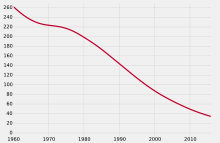
Trends in infant mortality (deaths per 1000 births)
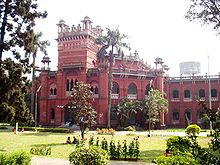
Curzon Hall , University of Dhaka
,_Islamic_University_of_Technology.jpg)
Front view of the Islamic University of Technology main building and the student center
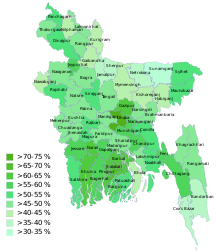
Literacy rate in the districts of the country (2011)
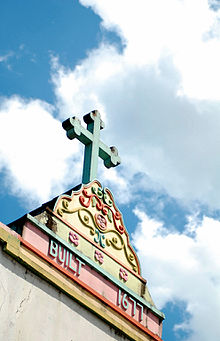
Gable cross of the Roman Catholic present-day Holy Rosary's Church ("Church of the Holy Rosary") in Dhaka, founded by Portuguese missionaries in 1677.
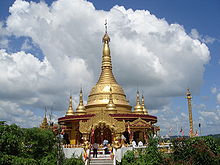
Buddhist temple (Buddha Dhatu Zadi) in Balaghata, Bandarban district

Shiva temple within the Dhakeshwari temple complex
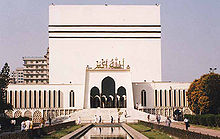
The Bait ul-Mokarram in Dhaka is Bangladesh's largest mosque
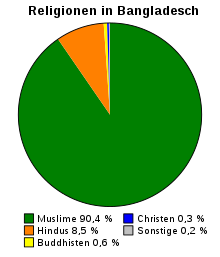
Source: Census 2011

Population density according to the 2011 census
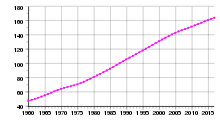
Population development (in millions)

Population pyramid 2016: Bangladesh birth rate declined significantly
Questions and Answers
Q: What is Bangladesh officially called?
A: Bangladesh is officially called the People's Republic of Bangladesh.
Q: What countries are near Bangladesh?
A: Countries that are near Bangladesh include the People's Republic of China, Bhutan, and Nepal.
Q: When did Bangladesh become an independent country?
A: Bangladesh became an independent country in 1971, breaking away from Pakistan after fighting a war in which over a million people died.
Q: What religion do most people in Bangladesh practice?
A: Most people in Bangladesh are Muslim.
Q: How large is the area of Bangladesh compared to other countries?
A: The area of Bangladesh is 57,320 mi² or (142,576 km²). It ranks 92 out of 195 sovereign countries by area and it is slightly smaller than Tajikistan.
Q: What are two main rivers located in Bangladesh?
A: The two main rivers located in Bangladesh are the Ganges and Brahmaputra River (called Padma and Jamuna in Bangaldesh).
Q: Why does flooding occur often in Bangladeshi regions?
A: Flooding occurs often in Bangladeshi regions due to the Ganges and Brahmaputra Rivers being important sources of economy as well as being sacred to Hindu people.
Search within the encyclopedia